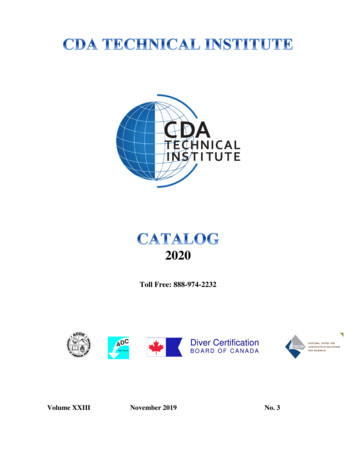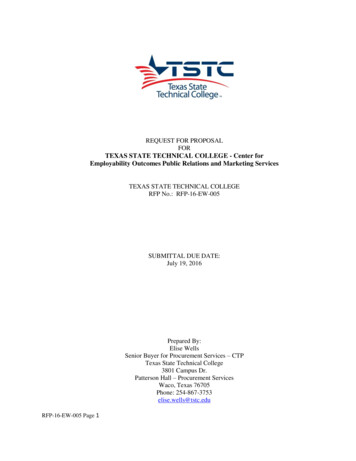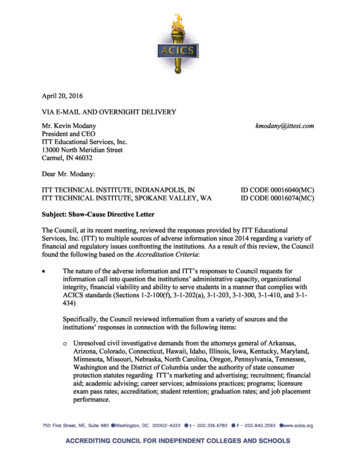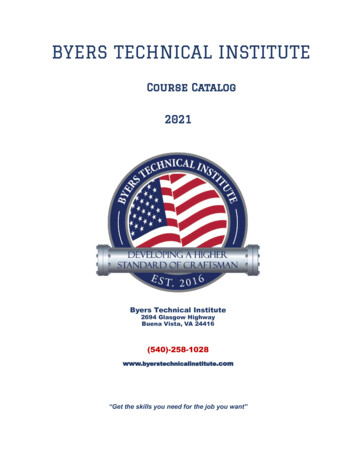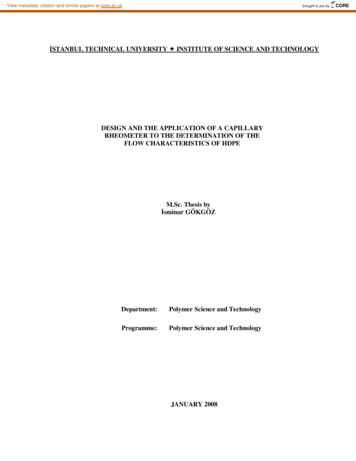
Transcription
View metadata, citation and similar papers at core.ac.ukbrought to you byİSTANBUL TECHNICAL UNIVERSITY INSTITUTE OF SCIENCE AND TECHNOLOGYDESIGN AND THE APPLICATION OF A CAPILLARYRHEOMETER TO THE DETERMINATION OF THEFLOW CHARACTERISTICS OF HDPEM.Sc. Thesis byİsminur GÖKGÖZDepartment:Polymer Science and TechnologyProgramme:Polymer Science and TechnologyJANUARY 2008CORE
İSTANBUL TECHNICAL UNIVERSITY INSTITUTE OF SCIENCE AND TECHNOLOGYDESIGN AND THE APPLICATION OF A CAPILLARYRHEOMETER TO THE DETERMINATION OF THEFLOW CHARACTERISTICS OF HDPEM.Sc. Thesis byİsminur GÖKGÖZ(515041022)Date of submission : 24 December 2007Date of defence examination:28 January 2008Supervisor (Chairman): Prof. Dr. F. Seniha GÜNERMembers of the Examining Committee Prof.Dr. Nurseli UYANIK (İ.T.Ü.)Prof.Dr. İsmail TEKE (Y.T.Ü.)JANUARY 2008
İSTANBUL TEKNİK ÜNİVERSİTESİ FEN BİLİMLERİ ENSTİTÜSÜHDPE’NİN AKIŞ KARAKTERİSTİKLERİNİNBELİRLENMESİ İÇİN BİR KAPİLER REOMETRETASARIMI VE UYGULANMASIYÜKSEK LİSANS TEZİİsminur GÖKGÖZ(515041022)Tezin Enstitüye Verildiği Tarih : 24 Aralık 2007Tezin Savunulduğu Tarih : 28 Ocak 2008Tez Danışmanı :Diğer Jüri ÜyeleriProf.Dr. F.Seniha GÜNERProf.Dr. Nurseli UYANIK (İ.T.Ü.)Prof.Dr. İsmail TEKE (Y.T.Ü.)OCAK 2008
PREFACEFirstly, I would like to thank my adviser, Prof. Dr. Seniha Güner, Prof. Dr. NurseliUyanık and Dizayn Group Reseach and Technology Development department fortheir invaluable supports. Especially, I would like to thank Dr. Zafer Gemici,department manager, for always being there to encourage me and help in guiding meon some mechanical engineering problems with Prof. Dr. İsmail Teke. I would liketo thank appreciate the support offered by my friends, Süleyman Deveci, Ümit Güler,Oktay Yılmaz, Volkan Uçar and especially Tamer Birtane for help in technicaldrawing of rheometer. I would like also to thank Atomika Technic Company whichis distributor of Malvern Instrument, Yrd. Doç. Dr. Necati Özkan and Dr.İlhan Özenfor their advices. Lastly, I would like to thank my parents for their continuedsupports.January 2008İsminur GÖKGÖZii
TABLE OF CONTENTSABBREVIATIONSLIST of TABLESLIST of FIGURESLIST of SYMBOLSÖZETSUMMARY1. INTRODUCTION2. BASIC CONCEPTS of POLYMER MELT RHEOLOGY2.1. Shear Viscosity2.1.1.Various types of Fluids2.1.2.Time-dependent flow behaviour2.2. Shear Rate-Dependent Viscosity Laws2.2.1.Power Law2.2.2.Bird-Carreau Law2.2.3.Cross Law2.2.4.Carreau-Yasuda Law2.3. Viscosity Parameters2.3.1.Viscosity Temperature Relationship2.3.2.Viscosity Molecular Weight Relationship2.3.3.Viscosity Pressure Relationship2.4. Normal Stress2.4.1.Normal Stress Effects3. SOME COMMONLY USED RHEOMETERS3.1. Poiseuille and Couette Flows3.1.1.Capillary Rheometer3.1.2.Melt Flow Index3.1.3.Rotational Rheometers3.2. Rheometer Selection4. CAPILLARY RHEOMETER4.1. Types of Capillary Rheometer4.1.1.Controlled Shear Rate4.1.2.Nitrogen Gas Capillary Rheometer4.1.3.Inline/Online Capillary rheometer4.2. Useage Areas Of Capillary Rheometer4.2.1.Material characterization4.2.2.Thermal Stability4.2.3.Melt Density4.2.4.Process Control Optimization4.2.5.Melt Tensile Tests4.2.6.Thermal Conductivity Measurement4.2.7.Wall Slip Effect4.2.8.Pressure -Viscosity Relationship4.2.9.Die Swell Measurement5. EQUATIONS for SHEAR VISCOSITY 2
5.1. Velocity profile inside the tube5.2. Used Corrections5.2.1.Rabinowitch Correction5.2.2.Bagley Correction6. CAPILLARY RHEOMETER DESIGN6.1. Die6.1.1.Die Material6.1.2.Die Size6.2. Piston6.2.1.Piston Lenght6.2.2.Piston Size6.3. Barrel6.3.1.Barrel Material6.3.2.Barrel Size6.3.3.Maximum Pressure in the barrel6.3.4.Minimum wall thickness of barrel6.4. Operation Control Systems6.4.1.Pressure Measurement6.4.2.Temperature Measurement7. EXPERIMENTAL PART7.1. Set Up Parameters7.1.1.Temperature7.1.2.Shear Range Selection7.1.3.Min. and max. piston speeds7.2. Test Material and Procedure7.3. Capillary Rheometers Used As a Comparision Rheometry8. RESULTS OF CAPILLARY RHEOMETRY MEASUREMENTS8.1. Apparent Shear Rate Values8.2. Bagley Plots8.3. Calculating Shear Stress8.4. Comparision of Apparent Shear Viscosity Results for HDPE8.5. Determine Power Law Index9. 9
PEEKPESPMMAPPUHDPE: American Society for Testing and Materials: Ethylene/propylene/diene rubber: High density polyethylene: Low density polyethlene: Lineer low density polyethylene: Metallocene catalyzed polyethylene: Melt flow index: Melt flow rate: Medium density polyethylene: Polyethylene: Polyetheretherketone: Polyether sulfone: Polymethyl methacrylate: Polypropylene: Ultra high density polyethylenev
LIST of TABLESPage NoTable 1.1: Rheology since its inception in 1929. .2Table 6.1: Allowed piston load for a material having Sy 300MPa and E 207GPa. .63Table 7.1: Standart testing temperature suggected by ASTM D 3835. .69Table 7.2: Propereties of used HDPE. .71Table 7.3: Dynisco LCR 7000 capillary rheometer. .73Table 7.4: Malvern RH 10D capillary rheometer. .73Table 7.5: Designed capillary rheometer. .73Table 8.1: Apparent shear rate values for HDPE. .74Table 8.2: Measured pressure values for L/D 5. .75Table 8.3: Measured pressure values for L/D 10. .75Table 8.4: Measured pressure values for L/D 20. .75Table 8.5: Measured pressure values for L/D 25. .76Table 8.6: Linear Regression Results. .76Table 8.7: Shear stress values for HDPE. .77Table 8.8: Shear viscosity values of HDPE. .79vi
LIST of FIGURESPage NoFigure 2.1: Simple shear deformation.4Figure 2.2: Flow curves of fluids without a yield stress and with a yield stress. .6Figure 2.3: The flow curves of thixotropic and rheopexy fluid. .7Figure 2.4: Viscosity profile for a polymer melt. .9Figure 2.5: Non-Newtonian viscosity of a LDPE melt at several differenttemperatures. .12Figure 2.6: The effect of molecular weight on viscosity. .13Figure 2.7: Weissenberg effect. .19Figure 2.8: Die swell. .20Figure 3.1: The Poiseuille and Couette flows. .21Figure 3.2: Schematic of a melt index. .24Figure 3.3: Comparison of the MFI to other polymer processing techniques.25Figure 3.4: Comparison of two resins with MFI 1.0. .26Figure 3.5: Rheological comparison of three resins. .26Figure 3.6: Schematic diagram of basic tool geometries for the rotational rheometer;(a) concentric cylinder, (b) cone and plate, (c) paralel plate. .27Figure 3.7: Cone and plate rheometer. .28Figure 3.8: Parallel plate rheometer. .30Figure 3.9:Graph of application processes and shear rates. .32Figure 4.1:Schematic diagram of a capillary extrusion rheometer.33Figure 4.2: Slit die. .34Figure 4.3: Circular die. .35Figure 4.4: Automated nitrogen driven capillary rheometer designed as a twin boresystem.36Figure 4.5: Schematic diagram showing the principal features of a constant speedscrew extrusion type capillary rheometer. .36Figure 4.6: Side stream rheometer. .37Figure 4.7: Triple bore capillary rheometer. .39Figure 4.8: Rheotens. .41Figure 4.9:Triple bore capillary rheometer. .43Figure 4.10: Thermal conductivity probe.43Figure 4.11: Photograph of the severe melt flow instability. .44Figure 4.12: A typical flow curve of a linear polyethlene as determined by a capillaryrheometer.45Figure 4.13: Pressure fluctuations indicate melt fracture in HDPE. .46Figure 4.14: Slip at the wall in a sliding plate rheometer. .47Figure 4.15: Determine wall slip velocity .48Figure 4.16: Scheme of modified capillary rheometer with a back pressure device. .49Figure 4.17: Scheme of modified capillary rheometer for die swell measurement.50Figure 5.1: Pressure changing in capillar rheometer .55Figure 5.2: Bagley plot .55vii
Figure 5.3: Problems in Bagley correction. .56Figure 5.4: Orifice die method. .57Figure 6.1: Analysis of a straight centrally loaded piston.60Figure 6.2: End fixity coefficients of some structures. .61Figure 7.1: Dynisco LCR 7000 capillary rheometer .71Figure 7.2: Malvern RH 10D capillary rheometer .72Figure 7.3: Designed capillary rheometer .72Figure 8.1: Comparing the Bagley plots. .76Figure 8.2: Comparison of apparent shear viscosity results. .78Figure 8.3: Plot of the ln ( τ w ) versus ln ( γ ) for HDPE at 190 C. .79Figure 8.4: Flow curve of HDPE at 190 C. .80 aviii
LIST of SYMBOLSaaTAcp: Carreau-Yasuda index: Shifting factor: Area: Specific heatC1′ , C2′hDp: WLF equation constants: Distance: Extrudate diameterDcDbD piston EFHkILLaLeLp: Capillary diameter: Barrel diameter: Piston diameter: Activation energy: Force: Gap between the two parallel discs: Consistency index: Moment: Lenght of die: Actual length of the column: Effective length: Lenght of the pistonm barrelmMw: Mass of the barrel: Cross law index: Weight average molecular weightMcnNNaN1N2N3PpQQ totalrRR: Critical molecular weight: Power law exponent: Design factor: Nahme number: First normal stress difference: Second normal stress difference: Third normal stress difference: Pressure: Hydrostatic pressure: Volumetric flow rate: Total volumetric flow rate: Radius of gyration: Universal gas constant: Die radiusix
Rd: Radius of the discRb: Barrel radiusR0: Radius of outer cylinderRi: Radius of inner cylinderRp: Radius of the plateRwSSytTTT0: Radius of the roller: Wall thickness: Yield strenghtTg: Glass transition temperatureTsVVR: Standart temperature: Angular velocity: Wall slip velocity: Velocity: Velocity at coaxial rheometryVbarrel: Volume of barrelVp: Piston speedVs Pc Pent: Slip velocity: Pressure drop across the capillary: Entrance pressure drop Ptotal T: Total pressure drop: Temperature difference: Shear strain: Shear rate: Cone angle: Pressure coefficient: Shear viscosity: Apparent shear viscosityννsγ γαβηη apη0η Ωµτστcτeω: Time: Torque: Temperature: Referance temperature: Zero shear viscosity: Infinity shear viscosity: Rotational speed: Density: Shear stress at the capillary wall: Tensile strength value of barrel material: Critical wall shear stress: Extensional stress: Angular velocityx
HDPE’NİN AKIŞ KARAKTERİSTİKLERİNİN BELİRLENMESİ İÇİN BİRKAPİLER REOMETRE TASARIMI VE UYGULANMASIÖZETPlastik malzemelerin üretim prosesini anlayabilmek için, kullanılan ekipmanözelliklerini bilmek yeterli değil aynı zamanda malzeme davranışlarının da bilinmesigerekir.Bu durumda, reoloji malzemelerin proses koşulları altındaki akış davranışlarınıntespitinde önemli bir rol oynar. Bilindiği gibi reoloji malzemelerin uygulanan birgerilim altındaki akış ve deformasyonu ile ilgilenir.Günümüzde, malzemelerin reolojik özelliklerini karakterize etmek için kullanılan birçok çeşitte reometreler vardır. Bunlar rotasyonel ve kapiler reometre olmak üzere ikigeniş katagoriye ayrılabilirler. Rotasyonel reometreler genellikle malzemelerin düşükkayma oranlarındaki akış özelliklerini belirlemek için tercih edilirler. Aynı zamandamalzemelerin elastik özelliklerini tespit etmek için de kullanılabilirler. Bunun dışındabir kapiler reometre malzemelerin daha yüksek kayma oranlarındaki akışözelliklerini belirlemek için tercih edilirler.Kapiler reometrenin kayma oranı kontrollü, nitrojen gazlı, iki ya da üç hazneli gibi.bir çok çeşidi vardır. Bu çalışmada, malzemelerin akış özelliklerini tespit edebilmekiçin kayma oranı kontrollü kapiler reometre dizayn edildi. Test cihazı bir hazne, birpiston, ısıtma ve sıcaklık kontrol aygıtları, bir basınç sensörü ve bir kalıptanoluşmakta. İhtiyaç duyulan sabit piston hızı bir basma-çekme test cihazındansağlanmış ve kalıp boyunca oluşan basınç düşmesini hesaplamak için kalıp girişinebir basınç sensörü yerleştirilmiştir. Montaj işlemi tamamlandıktan sonra, yüksekyoğunluklu polietilenin akış davranışları bu kapiler reometre ile test edilmiştir.Bu çalışmada, kayma gerilmesi değerlerinin hesabı için Bagley Düzeltmesi’ne göreaynı çapta ve farklı uzunluklarda dört adet kalıp kullanılmıştır. RabinowitchDüzetmesi ve Güç Yasası da kayma oranı ve kayma viskozitesini hesaplamak içinkullanılmıştır. Sonuçları kıyaslamak için, yüksek yoğunluklu polietilen diğer ticarikapiler reometreler ile test edilmiştir.
İSTANBUL TEKN İK ÜN İVERS İTES İ FEN B İLİMLER İ ENST İTÜSÜ HDPE'N İN AKI Ş KARAKTER İST İKLER İNİN BEL İRLENMES İ İÇİN B İR KAP İLER REOMETRE TASARIMI VE UYGU LANMASI YÜKSEK L İSANS TEZ İ İsminur GÖKGÖZ (515041022) OCAK 2008 Tezin Enstitüye Verildi ği Tarih : 24 Aralık 2007 Tezin Savunuldu ğu Tarih : 28 Ocak 2008 Tez Danı şmanı : Prof.Dr. F.Seniha GÜNER


